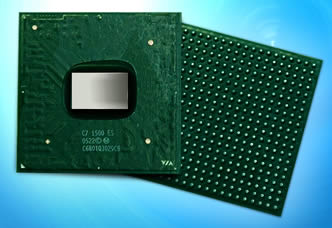
Pin-compatible with Pentium M, the VIA C7 processor family comes to compete AMD and Intel chipsets in terms of low power consuption and low thermal profile.
Formerly code-named "Esther," the C7 differs substantially from Via's current chip, which, oddly enough, is named the C3. For one thing, IBM will manufacture the chip in its East Fishkill, N.Y., facility with its 90-nanometer manufacturing processes. In the past, Via hired Taiwanese foundries. Because of the shift, the C7 will also incorporate a silicon-on-insulator substrate--an added layer of silicon that reduces power consumption. With a tiny die size of a mere 30mm2, the VIA C7 processor idle power is as low as 100mW (0.1W), while 2.0GHz will run at about 20 watts peak power.
Further, to cut energy consumption, Via has included technology that will slow down the processor during idle periods or when computing loads are light. At 1GHz, the C7 consumes a maximum of 3 watts, and 12 watts at 1.6GHz. But it can be cranked up quickly to 2GHz (and a 20-watt ceiling), if needed.
By comparison, AMD's Turion chips sport a thermal ceiling of 25 to 35 watts, depending on the model, and run at 2GHz and lower. Intel Pentium M chips consume between 27 and 55 watts and run at 2.13GHz. Exact comparisons in performance and power consumption are difficult and the results in reality depend on the overall system design.
The VIA C7 processor is a Pentium M pin-compatible CPU, especially targeted at mainstream thin and light notebooks, mini PCs, green clients, personal electronics such as home media centers and PVRs, and high density server and server appliances that leverage the winning low power, low heat, high performance and high security combination.
"For me, the 'Esther' core is the embodiment of my vision for a cool, secure and versatile processor that will take the x86 platform to the next level," said Glenn Henry, President of Centaur Technologies and chief architect of the power-efficient processor design strategy. "It is the culmination of many years of designing for the optimal balance of mobility, performance, and security."
Initially to be launched at speeds of up to 2.0GHz, the VIA C7 processor boasts the highly efficient VIA V4 bus interface with speeds of up to 800MHz with competitive write bandwidth and linear ordering modes, as well as SSE2 and SSE3 support for enhanced multimedia performance, and 128KB of both L1 and L2 on-die cache memory.

The VIA C7 processor also features the VIA PadLock Hardware Security Suite, a family of security technologies providing on-die hardware acceleration for key cryptographic operations. In addition to the random number generator (RNG) and AES Encryption Engine in the previous processor generation, the VIA C7 processor adds SHA-1 and SHA-256 hashing for secure message digests, and a hardware based Montgomery Multiplier supporting key sizes up to 32K in length to accelerate public key cryptography, such as RSA(TM). The VIA C7 also provides execute protection (NX), providing protection from malicious software such as worms and viruses, and is used in Microsoft(R) Windows(R) XP with SP2. Another feature allows a user to encrypt a voice over Internet Protocol (VoIP) call made through a notebook. The software to enable these options will come out later.
VIA C7 Processor Availability
The VIA C7 processor will enter mass production at the end of Q2. For more information on the VIA C7 processor, please visit the VIA website at:
http://www.via.com.tw/en/products/processors/c7.